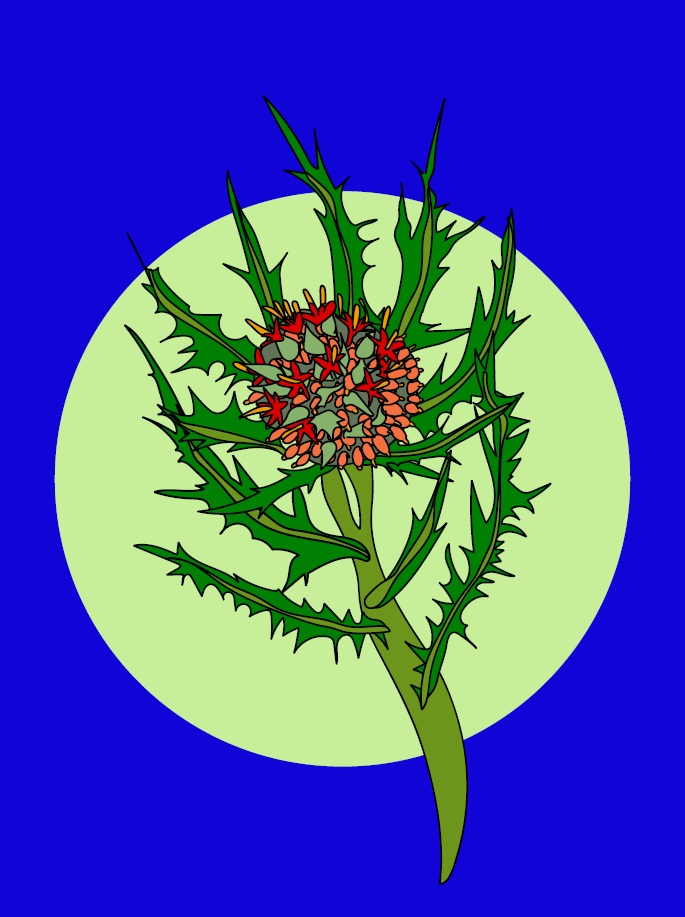The Art of Becoming Ecologists in a Dying World
By Vijay Kolinjivadi and Aaron Vansintjan
This is a modified excerpt from The Sustainability Class: How to Take Back Our Future from Lifestyle Environmentalists, published by The New Press (2024). The book looks at how sustainability has become elitist, and what a different practice of ecology could look like. In the chapter from which this essay is excerpted, the authors explore the meaning of ecology, exploring the colonial history of conservation and soil ecology, and contrasting them to liberatory, imaginative ways of relating to the land and each other.

In the hilly and grassy landscapes of Liwa al-Quds (East Jerusalem), but also further north in Nablus and the Galilee, a plethora of ancient, wild, edible plants grow. This is a landscape where subtle changes in light and temperature have profound effects on vegetation. It is scattered with limestone rocks and green cover, providing excellent habitats for insects, snails, lizards, and gazelles. Among the plants that grow in the picturesque valley, ‘akkoub (Gundelia tournefortii)—a spiny thistle-like plant that tastes like a cross between artichoke and asparagus—has been an important food source for millennia.
As artist and director Jumana Manna writes, ‘akkoub is a “delicacy” and “culinary obsession” among Palestinians, dating back to Neolithic times. It is a wonder vegetable with many medicinal properties, such as treating diabetes, liver diseases, heart problems, and gastric pain. One needs thick gloves to pick the prickly leaves, covered in thorns. The thicker stems of ‘akkoub are then cooked with olive oil and yogurt sauce.1 For many Palestinians, foraging ‘akkoub and other edible legumes in these rocky hills not only provides nutritious food, but also connects people to the land. In Manna’s 2022 film Foragers, we see that when foragers cut the plant back at the base, they also protect it from wildfire and thus encourage its preservation and replenishment.2 It is in large part because people forage ‘akkoub that it grows and thrives, and that the soil and landscape are protected, which highlights the intimacy between human existence and ecological thriving.
But the film also documents how the lands once belonging to Palestinian villagers who foraged ‘akkoub since time immemorial were confiscated in the 1948 Nakba—the violent displacement and ethnic cleansing of Palestinians from their homeland for the creation of the Israeli state. Since 2005, foraging ‘akkoub has been forbidden by the Israel Nature and Parks Authority to supposedly preserve them from extinction. Ironically, however, the ban on foraging has made the plant more vulnerable to devastating wildfires. The result of the foraging ban has meant less ‘akkoub, not more.
Ecology of Entrenchment
This example begs us to think twice about what ecology is. Is an ecosystem a fenced off wilderness, or is it something that is cultivated and tended to, a relationship? In the film, when a group of foragers are arrested by Israeli authorities for foraging ‘akkoub and asked if they knew about the environmental harms of their actions, one replies back, saying: “I am nature, okay? I would not hurt myself.”3
That, in one quote, is a suitable summary of our argument in our book The Sustainability Class: How to Take Back Our Future from Lifestyle Environmentalists. Ecology is not a state we can achieve or attain. Rather, it is a system—and often a conflict between different systems. There are many different types of ecological relations, and they don’t all necessarily imply fostering conditions for life to thrive. In one such system, problems are “fixed” by making them into consumable products—by fencing them off and, if possible, charging an entrance fee. It is the ecology promised by the sustainability class—wealthy “progressive” urbanites convinced that we can save the planet through individual action, smart urbanism, green finance, and technological innovation. This is an ecology that promises sustainability, when, in fact, it is all about reducing the world to efficient streams of profit, maintaining the status quo, entrenching it further—“fixing” it. But this means continuing as before while pretending nothing is actually wrong. It’s right there in the word: sustainability has come to mean sustaining the present order of things. And this is indeed what the sustainability class desires—to change nothing that will threaten their way of life.
Could there be another ecology, which does not try to fix the present to be an ever more efficient version of itself? To understand what that would look like, it can be helpful to examine another hotly contested word: nature. While in one ecology, nature must be fenced off, separated from humans, in other ecologies, nature is a relationship. This distinction can help us get toward an ecology of transformation.
Commodifying Nature
What comes to mind when you hear the word “nature”? Maybe a forest glen with a waterfall or a coral reef. Maybe a safari with rhinos, elephants, and zebras. Maybe someone doing yoga on a beach at sunrise. Or maybe an overgrown lot in between construction sites. Often nature is considered a space where human beings don’t typically reside—a pristine, untamed, and depopulated wilderness. A forest outside of a city is nature. The city itself is unnatural, manmade.
That nature—the kind that you can post to Instagram, the #lifegoals kind—is a hot commodity. According to one report sponsored by National Geographic, “nature” is considered an “underexploited asset” and is a major economic revenue source.4 The report claims that conservation of 30 percent of Earth’s land and waters in protected areas or reserves (a major goal for big corporate environmental NGOs like the World Wildlife Fund) can generate between $64 billion and $454 billion per year by 2050. Indigenous peoples, peasant farmers and pastoralists will be thrilled to know that their land will now become even more lucrative for nature conservation and tourism industries, and in turn for the airline industry, construction firms for airports, luxury hotels, shopping malls, real estate speculators . . . the works, right?
But if you think about it, there isn’t really anything natural about nature. Sometimes what we understand as untamed and “protected” nature is a landscape that has been carefully managed for a particular purpose, such as tourism. No different, then, from a busy manicured city park. As geographer David Harvey once quipped, “There is nothing unnatural about New York City.”5 We could go even further: there is nothing natural about nature. Nature is not an established fact; it is managed and mediated by beliefs, culture, technology, and the economy. Nature reserves and wildlife parks aren’t just nature protected from humans; they are a created vision of nature imposed by one group of people on others, like the Israel Nature and Parks Authority and Palestinian foragers, or the big game reserves across East and Southern Africa.
The Feeling of Africa
In their book The Big Conservation Lie, Kenyan authors John Mbaria and Mordecai Ogada show how nature reserves set up by European colonial powers in large swaths of East Africa damaged the delicate balance between pastoralist cultures and the large African animals we know so well.6 So, even though the aim was to protect nature, the outcome was more human-wildlife conflicts, overgrazing where pastoralists were made to be sedentary, drier microclimates, and reduced soil fertility leading to desertification. Unspoiled visions in one place create very spoiled visions in other places, or even in the same place—unbeknownst to the safari-going consumer.
The centuries-old tradition of kicking peasants, Indigenous peoples, and pastoralists off their land in the name of conservation has both dehumanizing and ecologically damaging impacts. From very early on, British colonizers sought to protect megafauna for hunting and tourism in East Africa, and this strategy inspired the international nature conservation agenda at the turn of the twentieth century.7 Today in Tanzania, more than seventy thousand Indigenous Maasai are facing eviction from their ancestral pastoral lands in Loliondo by a United Arab Emirates–based conservation company that wants to create a wildlife corridor for trophy hunting and luxury safari tourism.8 The Maasai are being relocated to a buffer zone near the Ngorongoro Conservation Area designated for both wildlife and people and will join eighty thousand other Maasai who have already been evicted. In other hot-ticket locations like Namibia, trophy hunting has even been rebranded as “conservation hunting” – masking the social and ecological consequences of altering age-old relationships for the sake of encouraging wealthy hunters to pleasure-hunt megafauna.9
Luxury safari tourism is now an export. Take Sharjah Safari Park in Dubai, which touts itself as “the world’s largest safari outside Africa.” Basically an open-air zoo, it is surrounded by hotel chains, restaurants, and shopping malls that monetize the experience of being in Africa, outside of Africa. As one Google reviewer, Fahad Anooni, said, “I felt like I was actually in Africa.” As if a massive continent can be rolled up into a single aesthetic experience. Sharjah Safari Park was so remarkable in its recreation of “Africa” that it even inspired the chief minister of India’s Haryana state, near Delhi, to make another branded version of the African wilderness—bringing cheetahs and lions from the African continent and a massive aquarium to the semi-arid and groundwater-depleted state. And get this: the money to fund this Indian safari park will come as an “eco-compensation” for the deforestation of 50 square miles of tropical rainforests and Indigenous territory of the Shompen and Nicobarese, some 1,500 miles away on Great Nicobar Island in the Bay of Bengal, which will make way for a new shipping port, international airport, and ecotourism resort.10 Trading biodiverse forests teeming with life still unknown to science and Indigenous cultures that have resided on Great Nicobar Island for thousands of years for “low carbon” ecotourism resorts and a reforested safari park with shipped-in cheetahs from Africa in a water-scarce arid climate more than a thousand miles away, all in the name of nature protection? Go figure. We can’t help but see similarities between the dispossession of people for “nature” conservation and the way green real estate development gentrifies urban neighborhoods and prices out lower-income residents. All of these strategies commit grave ecological, and often human rights, violations just to refashion the world as a playground for the wealthy and then dare to call it green, sustainable, low-carbon, or eco-conscious—take your pick.
Whose Nature?
But hold on. Isn’t protecting nature—whichever interpretation one might have about it—a good thing? Not necessarily. Being clear about what and whose “nature” we refer to matters because otherwise any billionaire philanthropist can decide what kinds of “nature” he (usually he) wants to protect at the expense of those less powerful and in the absence of any due process of justice. Take, for example, Prince William, the heir to the British throne, who has called for protecting megafauna in Africa but has blamed the continent for being “overpopulated” and hence putting what he called “enormous pressure” on the private conservation reserves that British royalty have historically treated as their personal hunting grounds.11 For the British crown and conservation game reserves, protecting megafauna is a priority over the people who have lived among them for millennia. For them, “nature” in Africa means untamed wilderness, depopulated of the African peoples who live there.
But others—including native Africans—might define nature differently. The ICCA Consortium, an association of 225 Indigenous people’s groups and their allies worldwide, does not use the language of nature conservation but instead refers to defending “territories of life.” They define these as “territories and areas that Indigenous peoples and local communities collectively conserve and consider at the heart of their identities, cultures, histories and livelihoods.”12 That might not satisfy the need for a clear and concise definition of nature. But they don’t need one: the point is that collective ownership, culture, health, living ecosystems, and livelihood are all interconnected. They point to many local terms for such territories, in many languages: “wilayah adat, himas, agdals, territorios de vida, territorios del buen vivir, tagal,qoroq-e bumi, yerli qorukh, faritra ifempivelomana, qoroq, ancestral domains, country, Mother Earth, community conserved areas, territorios autonomos comunitarios.”13 None of these mean anything like “nature,” but rather refer to living relationships and governance models. It’s clear that nature means different things to different people—and for many, the word itself is rather meaningless.
When people talk about conserving nature or saving the environment, they rarely mean the economic and political systems that prop up the ultra-wealthy. Instead they often blame working-class people, rural peasants, the urban homeless, and Indigenous people as the culprits of nature’s decline. Saving the environment becomes a matter of putting a fence around some piece of land so it can be reserved for Disney-fied safaris and then carving up the rest for intensive agriculture, development, and urbanization. As Ben Goldsmith, a leading advocate for convincing the elite to invest in nature, argued in a philanthropy-funded Guardian article, “It’s really cheap to fix nature. It recovers itself very quickly if you give it space. It’s not like building a hospital brick by brick, machine by machine. No huge investment is required to make things happen with nature.”14 What is left unspoken is that “fixing” nature requires very little from the rich—they can keep doing as they please as long as they set aside some of their billions to create conservation areas, as if there is an endless world of space to empty of people and refill with trees and imported big cats whenever a new pipeline or mining project is proposed. Surely there is something else that we can do to put a stop to the destruction of biodiversity, instead of relying on the rich to “fix” it for us, displacing millions of real human beings, and then blaming them (again) as overpopulating Earth when they get displaced elsewhere, all while selling out the rest of life to the highest bidder.
Ecologies of Possibility
That something else, we believe, means transforming the way we think about nature in the first place: not a thing that is “out there” to be protected, but an ecology of living and ever-changing relationships. As a very basic definition, we might think of ecology as being about dynamic relationships and interconnections. It is a co-evolving process, where species and their surroundings actively shape and are shaped by each other. Earlier we had mentioned rhinos as an example that comes to mind when the word “nature” is brought up. But for the Khoisan (a.k.a. the “Bushmen”) of central Namibia (the descendants of whom were pushed eastward towards Botswana following the German invasion and colonization during the early 20th century), rhinos were like brothers. While most grazing animals require water every few days, only the rhino shares the human requirement of daily water consumption. While rhinos were able to identify potential water sources in the arid landscape, they had poor eyesight. The Khoisan both depended on rhinos by following them in their daily movements towards water sources that they otherwise would not be able to locate on their own and, at the same time, supported the rhinos with an extra pair of eyes. The Khoisan even drew paintings of the direction of where rhinos were going on rock walls, just in case passing clans arrived and wanted to know where to get water themselves. Together, human and rhino worked together every day symbiotically to get their daily water. This relationship of nourishment is an ecology of reciprocity, each animal helping to shape the others’ environment.
In the past half century, archaeologists have collected convincing evidence that the history of humanity looks anything but linear: humans have built up complex hierarchical political and social systems throughout many periods of human history, and just as often intentionally dismantled them, often because people simply decided at a certain moment that what they were doing was no longer viable given changing environmental situations, and just wasn’t a great way to do things. From complex forager societies in the Great Plains of North America and the Fertile Crescent of the Levant to the Inuit of the Arctic to civilizations in Amazonia, societies moved fluidly back and forth across social structures with different value systems from one season or generation to the next. Settled agriculture and centralized governments were in many parts of the world conscious experiments, which were then abandoned when foraging and hunting, or decentralized governance, made more sense. As anthropologist David Graeber and archaeologist David Wengrow note when assessing this historical evidence, “with flexibility comes the capacity to step outside the boundaries of any given structure and reflect; to both make and unmake the political worlds we live in.”15
In contrast to our rich human history of experimentation, sustainability has come to mean less flexibility and greater discipline to accept one uniform and inescapable future. Sustainable development draws a straight line from the industrial revolution—roughly from Columbus’s violent “discovery” of the Americas—to a future that sustains in perpetuity this violent way of being and relating to the world .
But there is no “one-way future consisting only of growth,” as sci-fi writer Ursula K. Le Guin proclaimed.16 Ecology is contested, both historically and today—from how it is understood scientifically to how it plays out across continents. There are ecologies built on acting together with a whole concert of human beings and life, not on individual action and consumption. These are ecologies of possibility. They are prefigurative, even playful spaces of tinkering with relationships in ways that ensure both survival and mutual flourishing. Globalized capitalist ecology is confronting the consequences of severing life support systems. In response, we must all learn to be ecologists, organizing coalitions of solidarity both between each other and the non-human world. We will need to become underground roots, hidden from the surface, connecting and scheming, decomposing and fertilizing the social and political environment anew with creative ideas that cannot be co-opted by capital. Life finds a way to thrive in the most inhospitable and toxic environments, from the deepest undersea trenches to the driest deserts and frozen tundras, and the most paved-over concrete jungles. Reclaiming ecology is a political task and one informed by the science of relationships between all living things.
Meet the Contributors:
Vijay Kolinjivadi is an assistant professor at the School for Community and Public Affairs, Concordia University in Montreal, Canada.
Aaron Vansintjan is Policy Manager at Food Secure Canada and co-author of The Future Is Degrowth (Verso Books).
Notes
- Jumana Manna, “Where Nature Ends and Settlements Begin.” e-flux journal, Issue #113. Nov, 2020.
- Foragers. Video. Directed and written by Jumana Manna, Released September 15, 2022.
- Laura Allsop, “Laura Allsop on Foragers + An Excavation”, Open City Documentary Festival, London (April, 2024). https://opencitylondon.com/news/7273/.
- Anthony Waldron et al., “Protecting 30% of the Planet for Nature: Costs, Benefits and Economic Implications,” Campaign for Nature, 2020, www.conservation.cam.ac.uk/files/waldron_report_30_by_30_publish.pdf.
- David Harvey, “The Nature of Environment: Dialectics of Social and Environmental Change,” in Real Problems, False Solutions: Socialist Register 1993, ed. R. Miliband and L. Panitch, (London: Merlin Press, 1993).
- John Mbaria and Mordecai Ogada, The Big Conservation Lie: The Untold Story of Wildlife Conservation in Kenya(Auburn, WA: Lens & Pens, 2016).
- Corey Ross, “Tropical Nature in Trust: The Politics of Colonial Nature Conservation,” in Ecology and Power in the Age of Empire: Europe and the Transformation of the Tropical World (Oxford: Oxford University Press, 2017).
- Laurel Sutherland, “Tanzania, Siding with UAE Firm, Plans to Evict Maasai from Ancestral Lands,” Mongabay, Feb. 18, 2022, news.mongabay.com/2022/02/tanzania-siding-with-uae-firm-plans-to-evict-maasai-from-ancestral-lands.
- Earth Negotiations Bulletin, Vol. 31, No. 77, Page 3, 11th Plenary of the Intergovernmental Science-Policy Platform on Biodiversity and Ecosystem Services (IPBES-11).
- Vaishnavi Rathore, “Can a Safari Park Outside Delhi Make Up for a Lost Nicobar Forest?,” Scroll, Apr, 19, 2023, scroll.in/article/1047526/can-a-safari-park-outside-delhi-make-up-for-a-lost-nicobar-forest.
- Ben Webster, “Prince William Blames African Population Pressure for Wildlife Loss,” The Times, Nov. 23, 2021, www.thetimes.co.uk/article/prince-william-blames-african-population-growth-for-wildlife-loss-d7rtjlp3d; Nada Farhoud, “Royals’ Bloody Trophy Hunting Past When Queen Posed with Tiger Shot by Prince Philip,” Daily Mirror, Jan. 29, 2021, www.mirror.co.uk/news/uk-news/royals-bloody-trophy-hunting-past-23410242.
- “Defending Territories of Life and Their Defenders: Policy of the ICCA Consortium,” ICCA Consortium, Nov. 13, 2018, www.iccaconsortium.org/wp-content/uploads/2019/05/EN-Defending-Territories-of-Life-and-Their-Defenders-final.pdf.
- “Territories and Areas Conserved by Indigenous Peoples and Local Communities,” ICCA Consortium, Jan. 15, 2019, www.iccaconsortium.org/discover.
- Patrick Greenfield, “Record $5bn Donation to Protect Nature Could Herald New Green Era of Giving,” The Guardian, Sept. 29, 2021, www.theguardian.com/environment/2021/sep/29/record-5bn-donation-to-protect-nature-could-herald-new-green-era-of-giving-aoe.
- David Graeber and David Wengrow, The Dawn of Everything: A New History of Humanity (London: Penguin 2021), 155.
- Ursula K. Le Guin, “A Non-Euclidean View of California as a Cold Place to Be,” 1982. Reprinted in U.K. Le Guin, Dancing at the Edge of the World. London: Gollancz, 1989.





